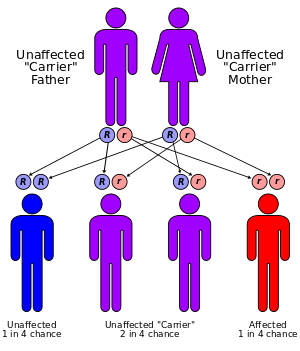Acrodermatitis enteropathica
Acrodermatitis enteropathica is an autosomal recessive[1] metabolic disorder affecting the uptake of zinc, characterized by periorificial (around the natural orifices) and acral (in the limbs) dermatitis, alopecia (loss of hair), and diarrhea.
Similar features may be present in acquired zinc deficiency. This disease also is related to deficiency of zinc due to congenital causes.
Other names for acrodermatitis enteropathica include:
Signs and symptoms
Features of acrodermatitis enteropathica start appearing in the first few months of life, as the infant discontinues breast milk. There are erythematous patches and plaques of dry, scaly skin. The lesions may appear eczematous, or may evolve further into crusted vesicles, bullas or pustules. The lesions are frequent around the mouth and anus, and also in hands, feet and, scalp.
There may be suppurative inflammation of the nail fold surrounding the nail plate, known as paronychia. Alopecia (loss of hair from the scalp, eyebrows, and eyelashes) may occur. The skin lesions may be secondarily infected by bacteria such as Staphylococcus aureus or fungi like Candida albicans. These skin lesions are accompanied by diarrhea.
Genetics

Acrodermatitis enteropathica has an autosomal recessive pattern of
inheritance.
A mutation of the SLC39A4 gene on chromosome 8 q24.3 is responsible for the disorder.[3] The SLC39A4 gene encodes a transmembrane protein that serves as a zinc uptake protein. The features of the disease usually start manifesting as an infant is weaned from breast milk. This has led some scientists to suspect that human milk contains a beneficial substance that helps uptake of zinc and prevents the disease from being manifested while an infant is on breast milk.[4]
Treatment
Without treatment, the disease is fatal and affected individuals may die within a few years. There is no cure for the condition. Treatment includes lifelong dietary zinc supplementation in the range of greater than 1–2 mg/kg of bodyweight per day.
See also
References
- ↑ Wang, K; Pugh, Ew; Griffen, S; Doheny, Kf; Mostafa, Wz; Al-Aboosi, Mm; El-Shanti, H; Gitschier, J (April 2001). "Homozygosity mapping places the acrodermatitis enteropathica gene on chromosomal region 8q24.3". American Journal of Human Genetics 68 (4): 1055–60. doi:10.1086/319514. PMC 1275625. PMID 11254458.
- ↑ Stedman, Thomas Lathrop. 2005. Stedman's Medical Eponyms. Baltimore: Lippincott Williams & Wilkins, p. 170.
- ↑ Küry, S; Dréno, B; Bézieau, S; Giraudet, S; Kharfi, M; Kamoun, R; Moisan, Jp (July 2002). "Identification of SLC39A4, a gene involved in acrodermatitis enteropathica". Nature Genetics 31 (3): 239–40. doi:10.1038/ng913. PMID 12068297.
- ↑ Michalczyk, A; Varigos, G; Catto-Smith, A; Blomeley, Rc; Ackland, Ml (August 2003). "Analysis of zinc transporter, hZnT4 ( Slc30A4), gene expression in a mammary gland disorder leading to reduced zinc secretion into milk". Human Genetics 113 (3): 202–10. doi:10.1007/s00439-003-0952-2. PMID 12743795.
External links
|
|---|
| | 1-10 | |
|---|
| | 11-20 | |
|---|
| | 21-40 | |
|---|
| see also solute carrier family |
|
